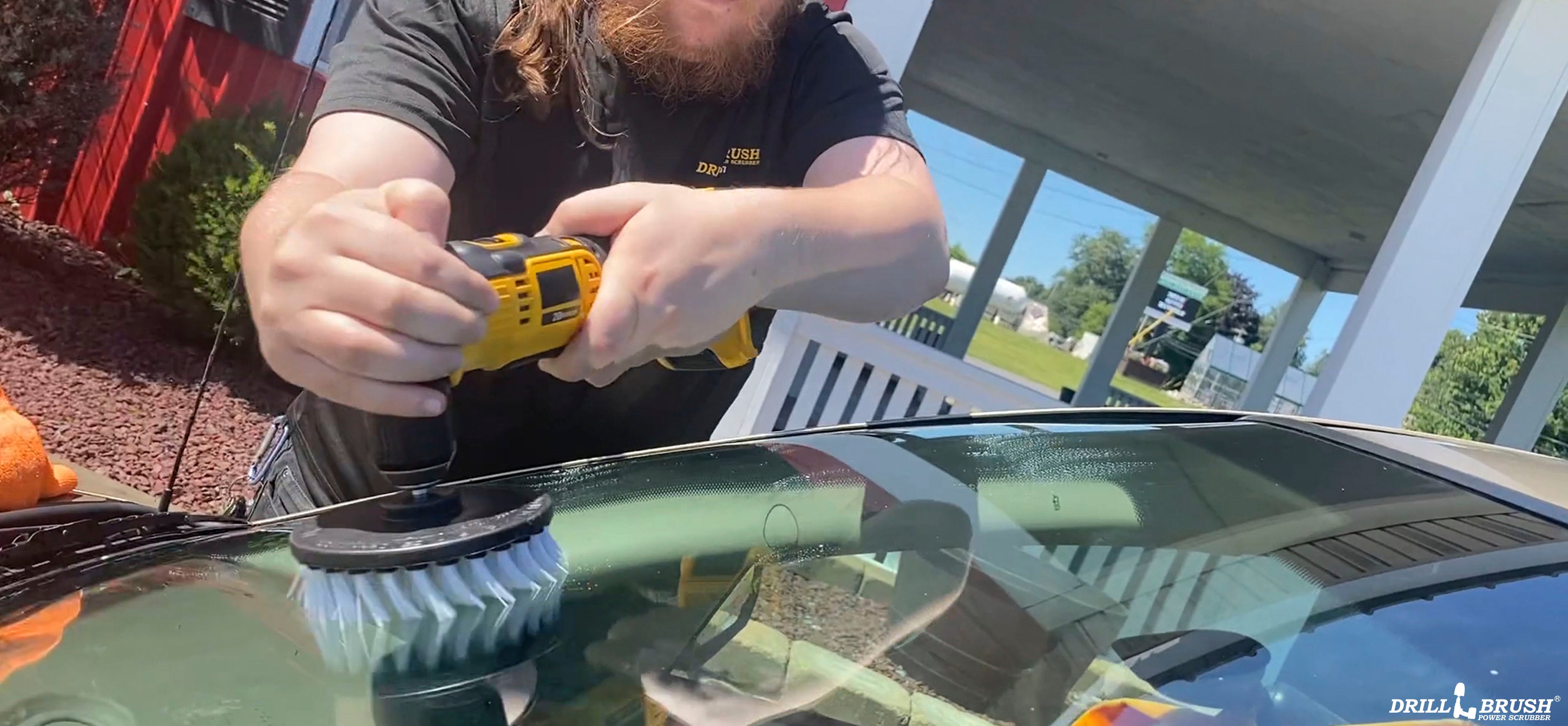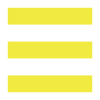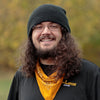Tips for Scrubbing Delicate Surfaces with a Drillbrush
Posted by John Cittadino on
Drillbrush products are designed to scrub away tough stains. Some brushes, like our Ultra Stiff Black brushes, can remove exceptionally difficult messes like burnt on food stuff, gristle, and deep-set stains on concrete.
This same toughness can also act as a point of concern for newer Drillbrush users, as some may worry that using a drill to clean surfaces could result in the surface being damaged.
Luckily, we’re here to assure that Drillbrush products are safe to use in most circumstances, as they have non-scratch bristles and won’t catch, tear, or wear away at most common household surfaces, like countertops, bathtubs, or sinks.
However, there are some instances where improper use and incorrect brush choice could result in issues on some delicate surfaces. There are also some surfaces that are just not made to withstand drill-powered scrubbing.
Today, we’ll look at the proper techniques for cleaning delicate surfaces and go over the surfaces that are better left for hand scrubbing.
Use Proper Brushes
 Drillbrush Soft White scrub brushes!
Drillbrush Soft White scrub brushes!
The first thing you’ll need when cleaning delicate surfaces is the right brushes. Too stiff of a brush can cause unwanted wear and tear, as well as clean ineffectively. Here are some brushes and pads we recommend.
Soft White Brushes and Long-Bristled Brushes
Our drill-powered scrub brushes come in a multitude of stiffnesses, from Soft White to Ultra Stiff Black. While all of these brushes have non-scratch nylon bristles, some of the higher stiffness brushes are too much for delicate or fragile surfaces.
This is why for gentle cleaning jobs, we recommend the Soft White Home & Auto brushes specifically. These bristles have the most give, meaning they’ll flex out of the way of fibers and imperfections on the surface rather than hold their ground like the Ultra Stiff bristles.
This feature makes the White Brushes the go-to for glass, fabric, and wood cleaning.
Bristle-length is also a factor, as longer bristles will flex more and make the brush softer. 1 inch Long Detail brushes have the longest bristle size of products we sell, with them being 2.5 inches in length. The tendril-like bristles can weave in-and-around tight spaces and make already soft brushes even softer!
 From Left to Right: Soft Orange, Soft White, and Foam Pad
From Left to Right: Soft Orange, Soft White, and Foam Pad
Soft Scrub Pads
Much like our brushes, we also have an assortment of drill-powered scrub pads. Our stiffest pads are coarse enough to remove rust and retexture metal surfaces. But today we’re focused on the other side of the spectrum; our Soft polishing pads.
Scrub pads can be daunting due to our large selection and multiple lines of them.You can read this for more information, but in short, anything designated “Soft,” “Very Soft” or “Foam” is used for polishing, buffing, and scrubbing glass and wood surfaces.
In our standard pads, we have the Soft White scrubber. There is a variant Soft Orange pad that is identical to the White version, but unique to the 38-piece kit.
In our legacy pads, the White pad is graded “Very Soft” with the “Soft” title going to the Light Blue Pad.
Lastly, we also have the unique Foam pad, which is made of a spongy material rather than non-woven nylon and polyester fibers like the others. It excels in window-washing, shower-door scrubbing, porcelain polishing, and other smooth glass surfaces. This pad is only available in the 38-piece kits.
 One buff boi!
One buff boi!
Cotton Buffers
The most delicate drill-powered scrubber in our line-up is the Cotton Buffer. This cylindrical buffer is covered in soft cotton fibers that feel like a teddy bear amongst power tools.
But don’t be fooled. The Buffer is great for automotive scrubbing and other gentle surfaces, as it can get inside rims, curve around headlight covers, and polish glass.
Go at a Slow Speed
 Use a feather touch, rather than going full bore!
Use a feather touch, rather than going full bore!
Drills are powerful tools with enough torque to drive screws and drill holes in hard wooden surfaces. Naturally, if you have something delicate to clean, you may be hesitant to use something that spins so fast.
However, you can try this simple solution; just don’t spin it as fast!
Drills are operated with a trigger that sends more power to the drill the more you squeeze it. On delicate surfaces, use less force when pressing the trigger and the brush will spin slower and allow you to do a less abrasive scrub.
This method is great when scrubbing cloth surfaces, like dinner chairs, curtains, and embroidered furniture. Light trigger usage is what we also recommend to do if you’re looking to reduce splatter (which you can watch a video on here.)/a> or need to pick up pet hair from couches and rugs (which we go over in this video.)
 If you’re a gentle drill user, adjust the settings on your drill to slow it down!
If you’re a gentle drill user, adjust the settings on your drill to slow it down!
If you don’t trust your trigger discipline, you can also just set your drill to a slower speed. Going to gear 1 and setting the dial to a lower number will keep the speed under control in case you go a little hard on the trigger.
Just make sure you don’t set it too low or you may struggle with certain scrubbing tasks. Play around with your drill’s settings and find something that feels right for you!
Tips for Specific Surfaces
Using the techniques we’ve already gone over, you can apply them to specific surfaces to get the best effect. Here are some strategies you can employ on some common delicate surfaces.
 White 5 inch Soft Drillbrush scrubbing a windshield.
White 5 inch Soft Drillbrush scrubbing a windshield.
Glass
Glass is often seen as a fragile material, and it certainly is if you drop a vase or get a baseball through your window. However, it’s actually fairly resilient to scratching, especially to our non-scratch nylon bristles. So there’s no worries about using our Soft White brushes to scrub your windows and windshields.
However, there are some precautions you should take when scrubbing small glass objects like pitchers, vases, coffee pots, and drinking glasses. You want to have good control over the brush when scrubbing, as an out-of-control brush can cause vibrations that could damage the item or cause you to drop it.
When cleaning glassware, especially if you’re using an extension, go at a manageable speed to maintain control on your drill. Glass is a smooth surface, so it shouldn’t require maximum power to scrub clean.
It is also wise to clean glassware in a sink or on a table, so in the event you fumble the item, it doesn’t fall onto your floor and make a huge mess.
Don’t let this scare you off, though. We’ve scrubbed many vases in our days without issue. Just approach it carefully and your glassware will shine!
 A 4 inch Soft Drillbrush scrubbing the top of a dirt-coated dresser.
A 4 inch Soft Drillbrush scrubbing the top of a dirt-coated dresser.
Wood
Wood surfaces vary in terms of brush strength. For example, coated wooden deck surfaces can handle our Stiff Red Outdoor and Patio brushes and even our Ultra Stiff black 7 inch brush.
It’s indoors where we start to get more gentle with our brushes, as coffee tables, dressers, kitchen tables, and chairs don’t have to be as protected from the elements.
For these surfaces, stick to Soft White flat brushes, as a Medium or higher will be too abrasive for certain finishes. Soft White detail brushes are also especially useful on wooden furniture with complex decorative trims, as well as intricate crown molding.
 A Soft White 2 inch Drillbrush being used on a fabric dining chair seat.
A Soft White 2 inch Drillbrush being used on a fabric dining chair seat.
Fabrics and Embroidery
Fabrics can be tough to clean, especially if they aren’t machine washable or have intricate embroidered pattern work.
Drillbrush products can be used on these surfaces, but first, determine whether or not a drill-powered brush is the best course of action for such a mess.
We would avoid using a Drillbrush if it has frayed or loose embroidery, is extremely fragile, or is very old. Antique cloth like this should be left to gentler cleaning solutions. In some cases, cloth materials might have specific washing instructions. If so, refer to them and save the Drillbrush for another mess.
If it is feasible for a Drillbrush, however, be sure to go at a very careful speed to prevent any excessive tugging.
 Cleaning the backseat of a sedan with a Soft White 5 inch Drillbrush.
Cleaning the backseat of a sedan with a Soft White 5 inch Drillbrush.
Leather and Upholstery
Unlike the embroidered fabric, leather and upholstery are much tougher and can handle more aggressive scrubbing.
Place down your upholstery cleaner of choice and use a flat White brush at a manageable speed. We’ve seen people successfully scrub some deep set food stains from the backseats of their cars, do massive car seat restorations on Youtube, and even scrub weather-worn chairs on a fishing boat.
We would avoid using a Drillbrush if the upholstery is cracked or peeling though, or if you see a lot of loose seams. Otherwise, Drillbrush products can clean sofas, car seats, and chairs in a flash!
 Detailing a tire wall with a Soft White 2 inch Drillbrush
Detailing a tire wall with a Soft White 2 inch Drillbrush
Auto Detailing
Soft White brushes are our designated Automotive scrubbers, which means they can be used all around the vehicle on windshields, seats, carpets, mats, and other places we’ve talked about in this section.
However, not everything on the car can be scrubbed with a Drillbrush, which brings us to…
Surfaces That Are Too Delicate
 Don't do these.
Don't do these.
While Drillbrush is a very handy and versatile scrubber, there are some circumstances where a drill-powered brush isn't the right tool for the job, such as tuning a piano or performing open heart surgery.
But in the cleaning space, it boils down to surfaces that are too delicate for the Drillbrush regardless of technique.
Big no-gos for the Drillbrush are car paint and delicate chrome. While the bristles themselves won’t leave scratches, dirt particles that cling to the bristles can, which can cause micro scratches on the paint at drill speeds. The same is true for chrome rims. For both surfaces, use traditional hand scrubbing methods to get them clean.
Similar surfaces it cannot be used on are glossy plastic, like on monitor bevels and tv screens, and frost etched glass, which is very fragile and can be easily rubbed away by a brush.
 An Ultra Stiff Black 5 inch Drillbrush removing chipped paint.
An Ultra Stiff Black 5 inch Drillbrush removing chipped paint.
You should also avoid surfaces with chipped or cracked coating, as it can further worsen the problem. However, if you do want to strip the coating to put down a new one, our Ultra Stiff Black brushes are great at it!
Our general rule of thumb is if it’s expensive, fragile, and precious, don’t use a Drillbrush on it. Always refer to the recommended cleaning techniques on such surfaces and only use a Drillbrush if you’re sure it’s the proper tool.
If you have questions about a surface we didn’t cover in this article, feel free to send us an email at info@drillbrush.com or message us on social media and we’d be happy to help.
Slow and Steady Cleans the Place!
With a steady hand, the right tools, and some trigger discipline, you can wash away the fear of damaging delicate surfaces around the house while still getting everything cleaned!
For more ways to clean and some advanced techniques, check out our Drillbrush Tips and Tricks video.
We also have blogs on other specific Drillbrush topics, like how to clean a brush, and an article on the various shapes our brushes come in.










0 comments